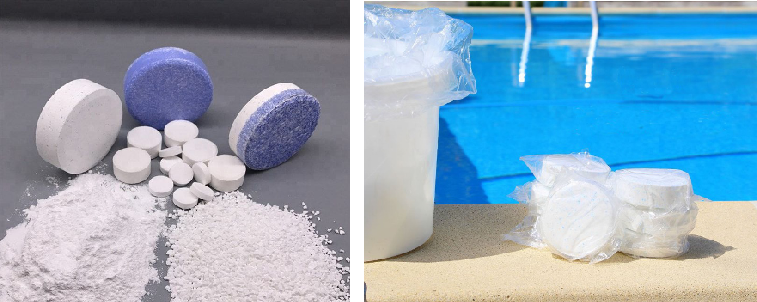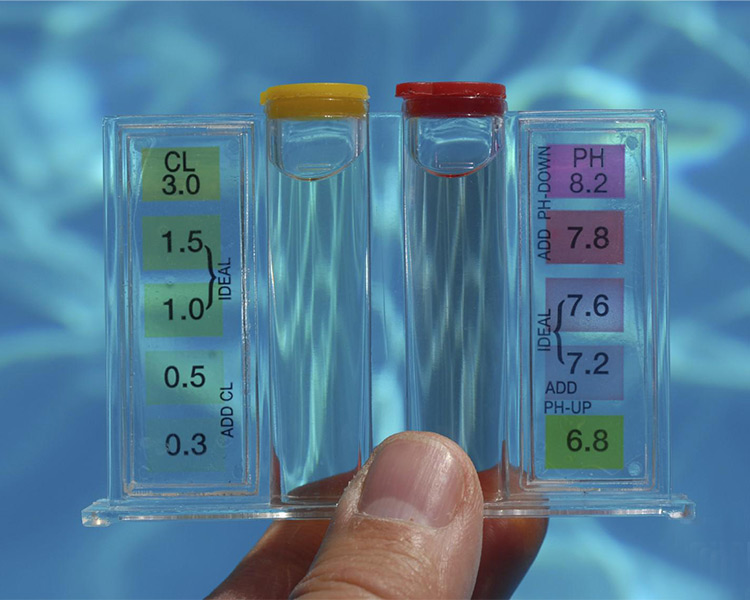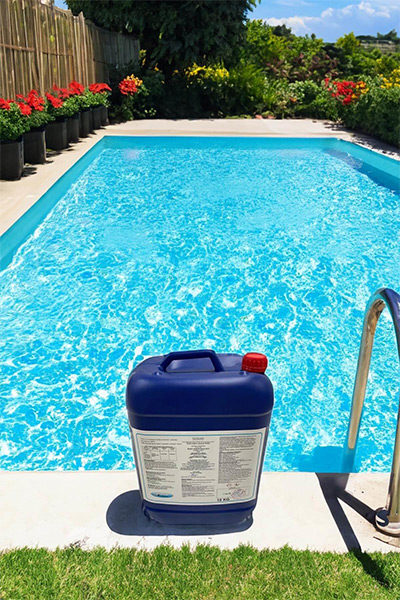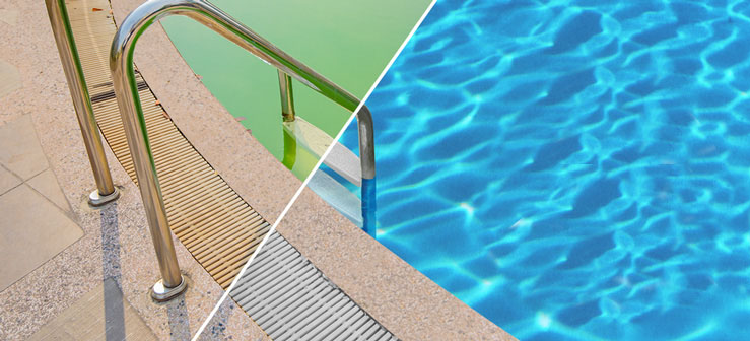Subject : Swimming Pool Chemicials
Date : 09.04.2020
Writer : Tekno Havuz & SPA
What is Pool Chemical and How to Use It?
Pool chemicals are substances used to improve the quality of pool water and create a healthy swimming environment for swimmers. Having clean pool water is a very important factor for the swimmer. Pool water should be clean, clear and free of harmful microorganisms. In general, the clarity and cleanliness of the pool is related to the performance of the pool filtration system. The cleanliness of pool water in terms of microorganisms is related to pool chemicals.
Even though the water is cleaned with a filter, microorganisms may still be present in the water. Water is the source of life. Bacteria, moulds, fungi and viruses that can easily live in water can multiply rapidly. Such situations are very dangerous for human health. With the use of chemicals, the proliferation of microorganisms is prevented and even completely eliminated from the pool water.
These chemicals may include many different types such as chlorine, pH regulators, algae inhibitors, descaling agents, and surface cleaners.
These chemicals must be disposed of in the right proportion and in the right way for the pool to be used healthily. Chemicals used in the right proportions keep the pool clean and hygienic for a long time. The ratio of pool chemicals in pool water should be monitored periodically. If not monitored periodically, chemical ratios become unbalanced. If too much or too little chemical is used, problems such as blurring of the pool color, algae, bad odor, fogging, browning, etc. will occur.
The most well-known pool chemicals are;
·Pool chlorine
·Pool water pH reducer-raiser
·Pool water anti-algae
·Pool water polisher
·Precipitator
·Ion binding
1. Chlorine
It is the most commonly used type of chemical. It is produced in different forms as liquid, powder and tablet. Each form has a different use. Generally, it disinfects the pool by destroying bacteria and fungi. Liquid chlorine acts quickly, but its retention in water, i.e. its stabilization, is low. It quickly moves away from the pool water under the influence of sunlight. Tablet chlorine dissolves slowly, but since it stays in water longer, it provides a longer-lasting disinfection. The type and size of the pool is important in choosing chlorine. Large and heavily used pools may require higher levels of chlorination. In addition, the sunlight the pool is exposed to and the number of users are also factors that affect the chlorine need. For correct chlorination, it is important to test the chlorine level regularly and adjust it where necessary.
The chlorine that has the disinfection effect in pool water is Cl- ions, which we call "free chlorine". Pool water must be clean in terms of physical dirt so that free chlorine can directly affect microorganisms. If the pool water is dirty, that is, if the pool filter is not working properly or is not installed correctly, the water cannot be filtered well. Organic impurities in the pool bind chlorine and prevent free chlorine from reaching microorganisms
USAGE: Free chlorine is administered manually or automatically between 0.5-1.5 mg/L in indoor swimming pools, depending on the type of pool usage (private & commercial), and between 1-3 mg/L in outdoor swimming pools, depending on the type of usage (private & commercial) is dosed. Please contact Tekno & SPA pool operator for control

2. Pool Water PH Reducer & Increaser
pH stands for "Potential of Hydrogen" or "Power of Hydrogen". The pH value indicates whether the pool water has alkaline or acidic properties. Ph value is measured between 0 and 14 units. As you move towards 0, it is understood that the environment is acidic, and as you move towards 14, it is understood that the environment is alkaline (basic). The value 7, which is the middle of 0 and 14, indicates that the environment is neutral (acid and alkaline are equal). The ideal pH range for pool water is between 7.0 and 7.6.
It is recommended to check the pool pH value every day. Because when chlorine is used in the pool, scientific studies have proven that the most effective disinfection range of chlorine is 7.6 pH and below. In other words, as the pool water moves towards the alkaline side, the disinfectant (chlorine) thrown into the water cannot show its disinfection effect. In other words, if the water is alkaline or the pH value is above 7.6, any chlorine thrown into the water will be wasted. For this reason, the PH value of the water should always be checked first, brought to the appropriate level, and then chlorine must be added. Additionally, pH values above 7.6 can harm human health. Irritation to skin and eyes may occur. If the pH value is high, a pH reducer must be used.
A PH value of 7.6 is good for disinfection, but low PH values, that is, on the acidic side, have other drawbacks. When the pH value drops below 7.0, all metal materials in the pool tend to rust. The color of the water changes. Low PH values also cause skin and eye irritation. Ph increaser is used for this.
USAGE: Depending on the needs of the pool, the pH reducer or booster is dosed manually or automatically to obtain a pH value of 7.0-7.6.
3. Pool Water Anti-Algae
For pools, free chlorine and pH values should always be within the required range. If a good chlorine & pH balance is maintained, there is no need to use algaecide. If this value range is not met, algae formation is observed on the edges of the pool or in the water. For such cases, algaecide is used. The function of the algaecide is to prevent the proliferation of "Algae". Algae inhibitors do not disappear into the water like chlorine, their concentrations decrease as fresh water is added to the pool, so they should be applied weekly.
USAGE: Tekno Pool &SPA recommended to use 1 liter of algaecide once a week in a 100 m3 pool.
4. Flocculant
Pool filters generally retain impurities between 20-100 microns, depending on the filter type. The size of microorganisms is generally between 0.1 and 10 microns. In addition, micro particles are generally between 1-50 microns. Micro particles in the pool water, which constantly increase in concentration in the water because they cannot be retained by the filter, may cause cloudiness in the water after a while. Generally, very fine dust particles, very fine plant parts, etc. Similar pollution may cause this. Flocculants clump these particles and increase their diameter, thus allowing them to reach a size that can be held in the filter. It ensures that those that cannot go to the filter sink to the bottom of the pool. These particles that settle to the bottom are thrown out of the pool by the bottom sweeping method. It is recommended to use the flocculant when necessary. The flocculator should be poured evenly into the entire pool and the engines should be kept off for at least 2-4 hours after pouring. During this period, the particles should be expected to clump together and settle to the bottom.
USAGE: Tekno Pool & SPA suggestion is 1 liter in a 100 m3 pool.
5. Pool Water Brightener
Pool water brightener, although its name is also mentioned as “polisher”, is essentially an alternative product to the flocculator. It coagulates the particles that cannot be flocculant by the precipitator and allows them to be retained more easily in the filter. Compared to the precipitant, the particles coagulated with this chemical do not settle on the pool bottom, but can all be kept in the filter as they remain suspended directly in the pool water. In addition, the brightening chemical oxidizes organic-based particles, making the pool water have a brighter appearance. Since pool water becomes brighter with a chemical effect, its use is not recommended unless necessary.
USAGE: Tekno Pool & SPA suggestion is 1 liter of rinse aid should be used 1 time per week in a 100 m3 pool.
6. Ion Binder
It helps in binding inorganic compounds such as calcium, magnesium, iron etc. in the pool. It is a type of chemical used to remove heavy metals such as When ground pool feed water is used due to calcium and magnesium levels, lime accumulation and a dull appearance occur on the pool walls over time. Ion trap reduces the accumulation of sulfate salts (Lime) on the walls. Similarly, water containing excessive iron ions causes the formation of a clear color in the pool, bad odor and leads to a decrease in filtration capacity. The ion trap eliminates these negative effects by binding iron. However, if the pool feed water is very hard water and very rich in iron ions, this water is not suitable for use as pool water. This type of water should not be used or should be softened with a separate system before use and given to the pool after the iron is separated.
USAGE: Tekno Pool & SPA suggestion is 4 - 20 liters should be used for 10 m³ pool water.
Tekno Tasarım ve Yapı Teknik A.Ş. has realized projects in 10 different countries and more than 50 cities in Turkiye, with an experience of more than 20 years. He is also the owner and operator of Aquacity Malatya (www.aquacitymalatya.com ). Therefore, it is the leading company in the sector in terms of providing the most accurate solutions to its customers and making the most trouble-free productions. The fact that it is also on the customer side of the sector with its references and its sister company is an indication of this capability. You, our valued customers, fill out the contact form at www.teknohavuz.com, send an e-mail to tekno@teknohavuz.com or call us at +90216 661 44 37 – +90530 281 88 91 (whatsapp) for our Istanbul regional office, for our Malatya Regional Office You can reach us at +90422 244 01 01 – +90530 281 88 96 (whatsapp) numbers. Work with Tekno Pool, don't get a headache



